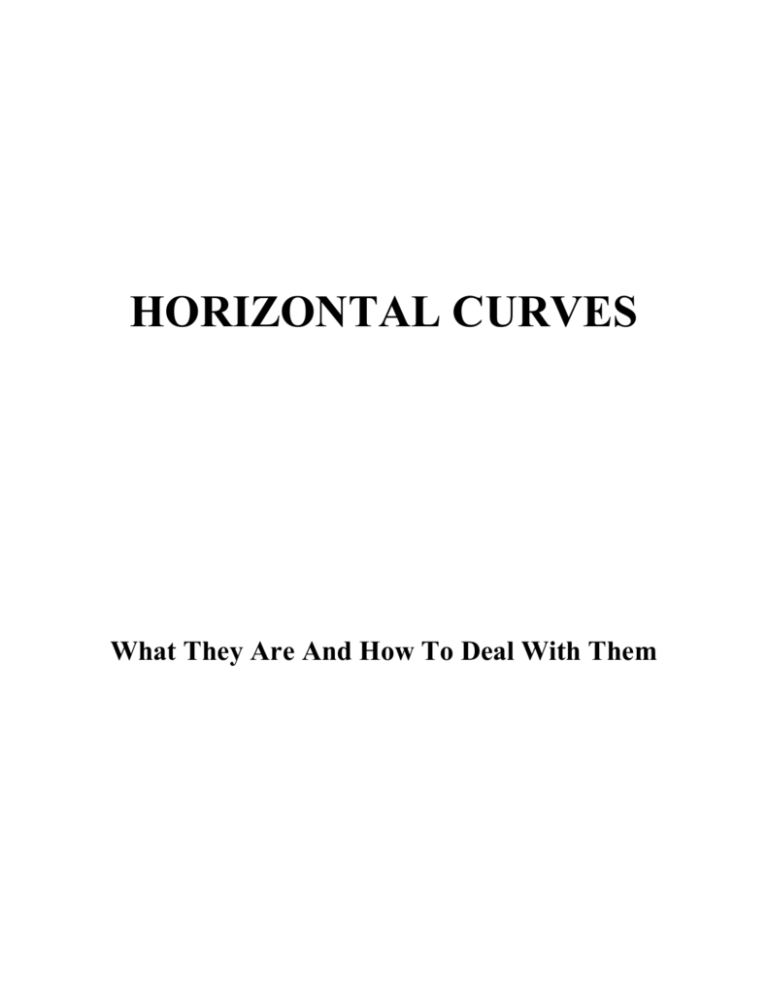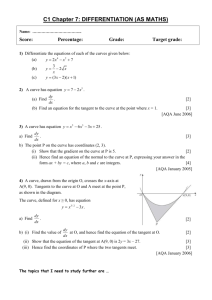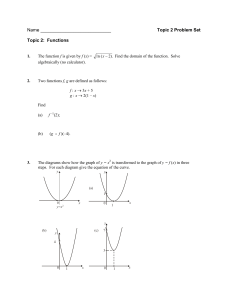HORIZONTAL CURVES
advertisement

HORIZONTAL CURVES What They Are And How To Deal With Them FOR 373 Fall Semester 2 FOR 373 Fall Semester HORIZONTAL CURVE TERMINOLOGY Symbol Terminology Equation LC Long Chord ∆ 2R sin 2 R Radius OA = OB = OC L Length of Curve L = 0.0174533 R ∆ T Tangent Distance ∆ T = AV = R tan 2 D Degree of Curve E External Distance MO Middle Ordinate ∆ MO = R(1 - cos 2 ) ∆ Central Angle AOC SC Short Chord varies mo Middle Ordinate for Short Chord varies D= 5729.578 R E = BV = 3 R ∆ cos 2 - R FOR 373 Fall Semester SELECTING THE DEGREE OF CURVE Curves are usually fitted to tangents by choosing a D (degree of curve) that will place the centerline of the curve on or slightly on or above the gradeline. Sometimes D is chosen to satisfy a limited tangent distance or a desired curve length. Each of these situations is discussed below: Choosing D to fit a gradeline (the most common case). When joining two tangents where the centerline of the curve is to fall on or slightly above the gradeline, the desired external is usually used to select D. 1. Delta (∆) is measured by a staff compass at the PI. 2. The desired external distance is measured. (This is done by standing at the PI, and facing the gradeline; lining each arm along the tangents; closing the eyes and bringing the arms together. This line of sight is used to bisect the interior angle.) 3. Find the external distance for a 1o curve with the measured ∆ using the equation for E, with a radius of 5729.578 feet: E1 = 4. 5729.578 - 5729.578 ∆ cos 2 Then D is calculated from: E1 D = Desired E 5. Curve data are then calculated as: R= 5729.578 D L = 0.0174533 R ∆ Ε= R ∆ cos 2 - R ∆ T = R tan 2 PC = PI - T PT = PC + L 4 FOR 373 Fall Semester Choosing D when the tangent distance is limited. The tangent distance must often be limited in setting a curve. Examples are stream crossings, bluffs, and reverse curves. In the case of stream crossings or bluffs, it is a matter of not starting a curve until a certain point is reached. In the case of reverse curves, the total tangent distance between PI's must be shared by two curves and not overlap. Some road standards may call for a minimum tangent between curves. In any case, where the tangent is limited, D is usually chosen by using the desired tangent distance. 1. The desired tangent distance is determined. 2. Delta (∆) is measured by a staff compass at the PI. 3. Find the tangent distance for a 1o curve with the measured ∆ using the equation for T, with a radius of 5729.578: ∆ T1 = 5729.578 tan 2 4. Then D is calculated from: T1 D = Desired T 5. Curve data are then calculated as: R= 5729.578 D L = 0.0174533 R ∆ Ε= R ∆ cos 2 - R ∆ T = R tan 2 PC = PI - T PT = PC + L 5 FOR 373 Fall Semester Choosing D for specific curve lengths (rarely used). Except on "Forest Highways" and as long a maximum curvatures for the desired road standards are met, curves should be kept as short as possible. If a reasonable sight distance is not attainable, the curve should be "double-tracked" or two-laned for safety. Thus in some cases, curve length may be used to choose D. 1. The desired curve length is determined. 2. Delta (∆) is measured by a staff compass at the PI. 3. D is calculated from: 100 ∆ D = Desired L 5. Curve data are then calculated as: R= 5729.578 D L = 0.0174533 R ∆ Ε= R ∆ cos 2 - R ∆ T = R tan 2 PC = PI - T PT = PC + L 6 FOR 373 Fall Semester CURVE LAYOUT Once D has been chosen and the curve data has been calculated, the curve may be set by a variety of methods. The most common methods of curve layout for forest roads are: (1) deflection angles; (2) tangent offsets; and (3) chord offsets. However, the deflection angle method requires instrument accuracies that necessitate the use of a transit. For this reason only the tangent offset and chord offset method will be discussed. Tangent Offsets: In the tangent offset method, distance measured from the PC and PT toward the PI (called TO's or tangent offsets) are used to set stations on the curve. Since deflection angles are the basis for this method, it is recommended that points on the curve be set at 100-ft, 50-ft, or 25-ft intervals. Procedure: 1. Determine the stationing to be used (i.e. 100 feet, 50 feet, or 25 feet) 2. Calculate the tangent distance and tangent offset for each station: 100 β = Stationing For each station to be established: γ = D * station number on curve β TD = R sin γ TO = R ( 1 - cos γ ) 7 FOR 373 Fall Semester Tangent Offset Method 8 FOR 373 Fall Semester Chord Offsets: The chord offset method of laying out a simple curve uses only a steel tape or surveyor's chain. It is a particularly effective way to "try out" a curve in a particular situation to see how it fits. Even though this method of curve location is mathematically correct, it is best suited to the location of curves whose lengths are equal to multiples of the chosen chord length. However, if the PC and PT of the curve are established in the usual way, the technique can be used to set POC's coming in from the PC and PT with given chord lengths and letting the odd distance fall in the center of the curve. Procedure: 1. Locate PC 2. Choose a chord length (c), usually 25 or 50 feet 3. Calculate the chord offset (a): c2 a = 2R 9 FOR 373 Fall Semester Chord Offset Method 10





